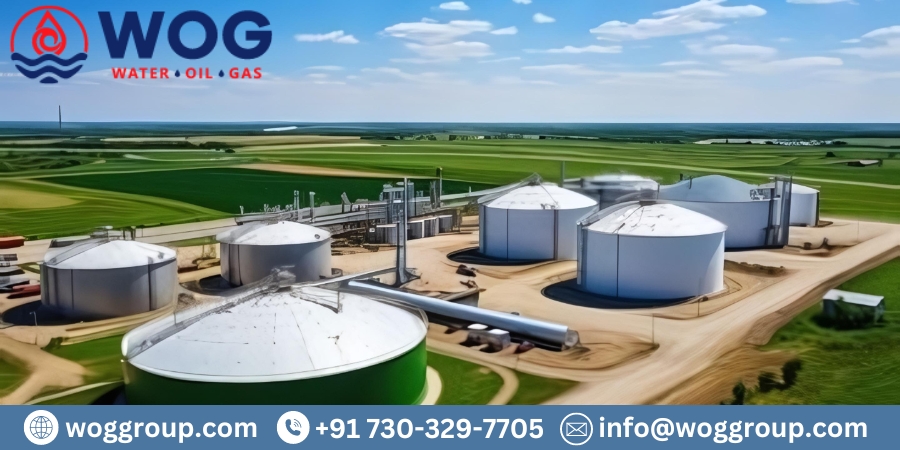Today, sustainable environmental solutions are crucial. Anaerobic digester system help manage organic waste and generate sustainable energy. Anaerobic Digester System operation and environmental benefits will be examined in this essay. Biogas is produced by microorganisms breaking down organic waste in anaerobic digesters without oxygen. Biogas is a renewable energy source for power production or fossil fuel replacement. Using organic waste to generate renewable energy is essential for lowering greenhouse gas emissions and fighting climate change.
Anaerobic digestion has additional environmental benefits.
This technique reduces greenhouse gas emissions like methane and ammonia, which pollute air and water. Anaerobic digestion produces digestate, a nutrient-rich fertiliser that eliminates the need for chemical fertilisers and promotes sustainable agriculture. Anaerobic Digester System produces renewable energy and manages organic waste sustainably.
How does anaerobic digestion work?
Anaerobic digestion produces biogas and nutrient-rich digestate from organic material without oxygen. An effective technique for turning organic waste into renewable energy and beneficial byproducts is the use of anaerobic digester systems.
Anaerobic digestion works as follows:
-
- Feedstock Preparation: To prepare feedstock, organic waste resources such as agricultural waste, food waste, sewage sludge, and energy crops are gathered and pre-processed to remove contaminants and speed up digestion. The anaerobic digester receives feedstock.
- Anaerobic Digester: An Anaerobic Digester System is a vessel or tank that breaks down organic material without oxygen. Anaerobic bacteria and other microorganisms thrive in the digester.
- Different Anaerobic Digestion Stages:
- Hydrolysis: Hydrolytic bacteria break down complicated chemicals into sugars, amino acids, and fatty acids.
- Acidogenesis: Acidogenic bacteria convert simpler compounds into alcohols, volatile fatty acids, and other intermediates.
- Acetogenic: Acetogenic bacteria create acetic acid, carbon dioxide, and hydrogen from intermediate metabolites. So this is acetogenesis.
- Methanogenesis: Microbes convert acetic acid and other chemicals into methane (CH4) and carbon dioxide (CO2), producing biogas.
- Producing Biogas: The anaerobic digester produces mostly methane (50–75%) and carbon dioxide (25–50%). It may be harvested and utilised to power industrial power plants, heat homes, and fuel cars.
- Digestate: Digestate, the nutrient-rich substance left following anaerobic digestion, can be utilised as manure in wastewater treatment for industrial processes or added to soil.
Environmental benefits of anaerobic digestion
- Energy Generation:
Anaerobic digestion produces biogas and power, a sustainable alternative to fossil fuels. Anaerobic digestion provides clean energy, making the energy mix greener during industrial water treatment.
- Waste Management:
Anaerobic digestion is a greener option than landfilling or burning organic waste. By sending organic waste to anaerobic digesters, the technique reduces landfill methane and leachate emissions.
- Nutrient Recovery:
Anaerobic digestion produces copious nitrogen, phosphate, and potassium in the digestate, making it a beneficial manure. Anaerobic digestion lowers nutrient runoff and water pollution by using digestate as a soil additive instead of synthetic manure.
- Waste Reduction:
Anaerobic digestion reduces waste by converting organic waste into useable goods, promoting a circular economy. Recycling organic matter into nutrient-rich digestate closes the loop by reducing dependency on virgin resources and improving resource efficiency.
- Greenhouse Gas Reduction:
Anaerobic digestion minimises greenhouse gas emissions, aiding in climate change mitigation. Methane produces biogas, a greenhouse gas that replaces fossil fuels. It reduces fossil fuel combustion and waste breakdown methane and carbon dioxide emissions.
Anaerobic digestion for Nutrient recovery & soil improvement
Anaerobic digestion helps recover nutrients and build soil by producing digestate, a nutrient-rich industrial waste. Anaerobic digestion improves soil quality and nitrogen recovery:
- Nutrient Concentrate:
Anaerobic digestion reduces organic waste into digestate with concentrated nutrients like nitrogen, phosphate, and potassium. Organic feedstock materials provide these nutrients.
- Organic matter Decomposition:
The process of anaerobic digestion simplifies organic matter, making it easier for plants to absorb nutrients. However, this method helps plants absorb nutrients from organic waste.
- Manure:
Anaerobic digestion provides nutrient-rich digestate, which can be used as manure or soil amendment. It contains organic matter and nutrients to improve soil fertility and provide plants the nourishment they require.
- Nutrient Recycling:
The process of anaerobic digestion can recycle nutrients into the soil by employing digestate as manure. Digestate prevents the need for energy-intensive synthetic manures by providing nutrients sustainably.
- Improvement of Soil Structure:
Digested organic matter improves soil structure and moisture absorption. It improves soil water retention, reduces erosion, and creates an optimum soil habitat for plant roots.
- Microbial Activity:
Digestate provides beneficial bacteria that promote soil health through microbial activity. Bacteria help nutrient cycling and water recycling, breaking down organic molecules and improving soil structure. They support biological diversity and activity in the ecosystem.
- pH Correction:
Occasionally, digestion may have a high or low pH. Digestate can neutralise soil pH, promoting plant development.
- Sustainability in Agriculture:
Sustainable agriculture uses digestate as manure to reduce resource use, chemical inputs, nutrient runoff, and water contamination.
Anaerobic Digestion in India
Digestate delivers sustainable nutrients, decreasing the need for energy-intensive synthetic manures. We have employed anaerobic digestion with sewage sludge and other substrates in India for years. We think anaerobic digestion is better in India since it produces methane and electricity. We know that anaerobic digestion demands temperatures above 25°C, which is accessible almost everywhere in India and year-round as sewage temperature.
Sludge management systems in major Indian wastewater treatment plants included thickening, digesters, and dryers. Water treatment in industrial technology uses less energy. High-quality water doesn’t need many chemicals. Manufacturing processes are being improved to reduce wastewater, which improves production research. Anaerobic digester systems are essential to modern waste management and renewable energy. They will certainly become more popular as technology progresses, boosting the circular economy and greener future endeavours.
About Us
Customers feel that the company creates cutting-edge industrial process water treatment plants. As a provider, we provide a choice of wastewater treatment plants and effective utilisation. India has long exploited the Anaerobic Digester System with a range of substrates, including sewage sludge. We feel that anaerobic digestion is the greatest option as, when burned in a gas engine, it delivers both methane and electrical energy. Above all, WOG Group solutions will help various industries with their wastewater processes.




